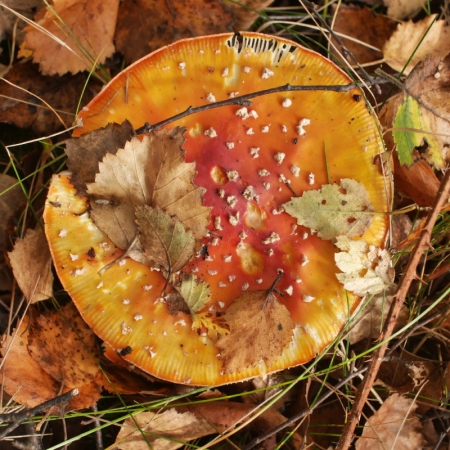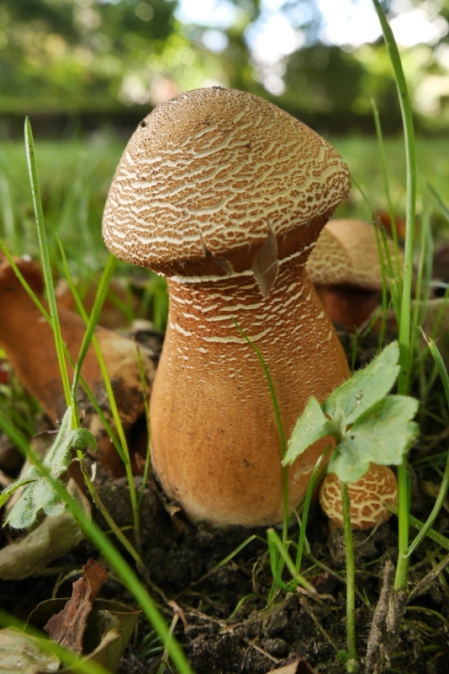Its been a very good year for Fly Agaric, Amanita Muscaria, where we live. Walking up a lane that goes along the top of a local beech wood a couple of weeks ago we were delighted to find about eighty of these gorgeous fungi. The photos above shows some that are going over, but still look wonderful, I think, as they melt back amongst fallen leaves. Photographing them felt like a suitable way of paying homage to a remarkable and surely extrovert denizen of the wood.
I was prompted to tap this dispatch by two programmes about fungi on the radio this morning, from which I gleaned the following more or less familiar morsels. There are about five million species of fungi, compared with about 100,000 species of plants. Without fungi there would be no life on earth. As decomposing agents they make room for new life to emerge, and release nutrients into the ecosystem. Fungi live underground, and within other organisms. Through their mycellia they supply water and minerals to trees, and get sugars in exchange. The mushrooms we see are the fruiting bodies, so are comparable to apples on a tree, or flowers on a plant. Every individual fungi releases billions of spores. Some release trillions.
In an edition of his fascinating Natural World series, Brett Westwood, a naturalist with an interest in cultural history, described the Fly Agaric as ‘brilliant’, ‘charismatic’, ‘magical’, and ’emblematic of autumn’. Unusually amongst fungi, the stunning Amanita Muscaria often elicits an affectionate response from humans. Unfortunately, though, they didn’t show for Brett on this particular foray with a mycologist in the New Forest. When you go out with a confident idea about who you expect to find this often happens, of course. In the event the no-show didn’t matter much as the programme focussed mainly on how stories about Siberian shamans’ use of Fly Agaric as an entheogen, and Gordon Wasson’s claim that it was the soma of the Rig Veda, have been taken up in the West -from Lewis Carol’s description of disturbed perceptions of space in the story of Alice, to Santa Claus and his flying reindeer.(1)
In another fungi programme Professor Lynn Boddy, a mycologist from Cardiff University, talked about her research that demonstrated that fungi were present in live branches within the canopy, and that when wood dries out they can quickly link up to form ‘extremely long individual decay columns’. I was surprised to learn that the canopy is where the decay process begins, and where much of it happens. Professor Boddy is also studying ‘extremely aggressive interactions’ between different species of fungi, which she likens to chemical warfare. Understanding the compounds secreted by fungi under such circumstances may be significant in relation to our human need to develop new anti-microbial agents, and in relation to biolgical controls of plant pathogens.(2) I wondered whether those Amanita Muscaria might be able to defend the beech trees against the bleeding canker that is currently marauding through our Victorian monoculture beech woods.
There are advantages to knowing a local patch well. On another perambulation of my rat run, about a month ago, I noticed that a new resident had appeared on the scene. Next to a fine group of about 40 shaggy ink caps, a cluster of quite striking and unfamiliar fungi were surfacing beneath a mature horse chestnut. I photographed them and sent a sample to an ex-neighbour who has become our local fungi specialist. She in turn took them to a meeting of the mid-Yorkshire fungi group where they were eventually identified as phaeolepiota aurea, a.k.a. Golden Bootleg or Golden Cap.
The unusually dry autumnal conditions meant that these specimins had an unusual cracked appearance, and were not able to reach prime condition (see here for more photos, and a description of the species). To make matters worse they were ‘cleared away’ by a gardener. Historically, mycologists have struggled to place the species within existing genera, so now regard phaeolepiota aurea as monotypic (in a genus of its own). The photos above show the fungi emerging from their ‘grainy sheath’. Local mycologists told me that ‘the texture of the cap surface and the underside of the ring are almost unique in their granular surface’. Pleasingly for my ego the species had not been recorded in the valley before.
There are too many species of fungi to be included in books, and identification often requires microscopic inspection (I’m not an expert), but having photographed the striking crop of fungi below I felt sure that they were Fammulina velutipes, Velvet Shank. These winter fungi are said to appear in abundance when wintry weather gives way to thaw and mild westerly airstreams -which is what happened here last week. The book that convinced me (Andreas Neuner, Chatto Nature Guide) said there was ‘no risk of confusion with other fungi that grow in clusters’ but didn’t mention a key point of identification -the lack of a ring (or sign of a ring) on the stipes or stalk. Many thanks to sporesmouldsandfungi for pointing this out and suggesting that these were probably a variety of Armillaria or honey fungus.
Happy wandering!
B.T. 15th November, 2016.
Sources:
(1) Brett Westwood, Natural Histories: Fly Agaric, B.B.C Radio 4, 15th November 2016.
(2) Jim Al-khalili, The Life Scientific, Interview with Professort Lynne Boddy, B.B.C. Radio 4, 15th November 2016.
For an account of some quite intimate animic relations with fungi visit Moma Fauna’s blog, here.
For a broad historical perspective on the political ecology of human-fungi relations see Anna Tsing, Unruly Edges, Mushrooms as Companion Species, Environmental Humanities, May 2016, 8 (1) : http://environmentalhumanities.dukejournals.org/content/1/1/141.full








Love the photos especially the Amanita muscaria. However your Fammulina velutipes have rings on their stipes so are probably an Armillaria. Cheers Geoff
Ooh. Thanks for that. The book that convinced me there was no risk of confusion (Neuner, Chatto Guide) didn’t mention the lack of ring! I’ve changed the text accordingly.
Thanks for your homage to these wonderful and all important beings 🙂